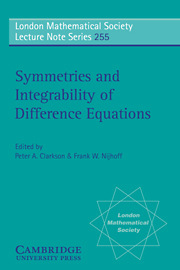Book contents
- Frontmatter
- Contents
- Preface
- List of Participants
- 1 Partial Difference Equations
- 2 Integrable Mappings
- 3 Discrete Geometry
- 4 Asymptotic Analysis
- 5 Discrete Painlevé Equations
- 6 Symmetries of Difference Equations
- An approach to master symmetries of lattice equations
- Symmetries and generalized symmetries for discrete dynamical systems
- Nonlinear difference equations with superposition formulae
- 7 Numerical Methods and Miscellaneous
- 8 Cellular Automata
- 9 q-Special Functions and q-Difference Equations
- 10 Quantum Aspects and Yang-Baxter Equations
Symmetries and generalized symmetries for discrete dynamical systems
Published online by Cambridge University Press: 04 August 2010
- Frontmatter
- Contents
- Preface
- List of Participants
- 1 Partial Difference Equations
- 2 Integrable Mappings
- 3 Discrete Geometry
- 4 Asymptotic Analysis
- 5 Discrete Painlevé Equations
- 6 Symmetries of Difference Equations
- An approach to master symmetries of lattice equations
- Symmetries and generalized symmetries for discrete dynamical systems
- Nonlinear difference equations with superposition formulae
- 7 Numerical Methods and Miscellaneous
- 8 Cellular Automata
- 9 q-Special Functions and q-Difference Equations
- 10 Quantum Aspects and Yang-Baxter Equations
Summary
Introduction
Nonlinear differential difference equations are always more important in applications. They enter as models for many biological chains, are encountered frequently in queuing problems and as discretisations of field theories. So, both as themselves and as approximations of continuous problems, they play a very important role in many fields of mathematics, physics, biology and engineering.
Not many tools are available to solve such kind of problems. If one is interested in obtaining just a few exact solutions a very important and sufficiently simple technique is provided by the group theoretical approach to the costruction of point simmetries. This approach is algorithmic and can be carried out by computer. In the case of differential difference equations it has been applied with success to a few classes of equations.
However, apart for a few exceptional cases the complete solution of nonlinear differential difference equations can be obtained only by numerical calculations or by going to the continuous limit when the lattice spacing vanishes and the system is approximated by a continuous nonlinear partial differential equation. Exceptional cases are those equations which, in a way or another, are either linearizable or integrable via the solution of an associated spectral problem on the lattice. In all such cases we can write down for those equations a denumerable set of exact solutions corresponding to symmetries of the nonlinear differential-difference equations.
- Type
- Chapter
- Information
- Symmetries and Integrability of Difference Equations , pp. 261 - 274Publisher: Cambridge University PressPrint publication year: 1999
- 1
- Cited by

